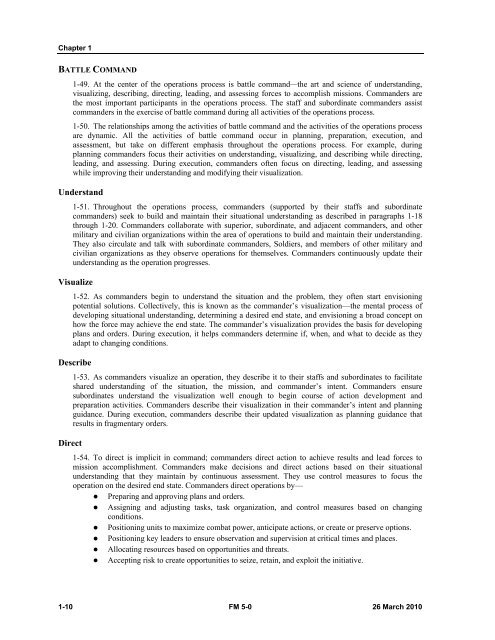FM 5-0, The Operations Process - Federation of American Scientists
FM 5-0, The Operations Process - Federation of American Scientists
FM 5-0, The Operations Process - Federation of American Scientists
You also want an ePaper? Increase the reach of your titles
YUMPU automatically turns print PDFs into web optimized ePapers that Google loves.
Chapter 1<br />
BATTLE COMMAND<br />
1-49. At the center <strong>of</strong> the operations process is battle command—the art and science <strong>of</strong> understanding,<br />
visualizing, describing, directing, leading, and assessing forces to accomplish missions. Commanders are<br />
the most important participants in the operations process. <strong>The</strong> staff and subordinate commanders assist<br />
commanders in the exercise <strong>of</strong> battle command during all activities <strong>of</strong> the operations process.<br />
1-50. <strong>The</strong> relationships among the activities <strong>of</strong> battle command and the activities <strong>of</strong> the operations process<br />
are dynamic. All the activities <strong>of</strong> battle command occur in planning, preparation, execution, and<br />
assessment, but take on different emphasis throughout the operations process. For example, during<br />
planning commanders focus their activities on understanding, visualizing, and describing while directing,<br />
leading, and assessing. During execution, commanders <strong>of</strong>ten focus on directing, leading, and assessing<br />
while improving their understanding and modifying their visualization.<br />
Understand<br />
1-51. Throughout the operations process, commanders (supported by their staffs and subordinate<br />
commanders) seek to build and maintain their situational understanding as described in paragraphs 1-18<br />
through 1-20. Commanders collaborate with superior, subordinate, and adjacent commanders, and other<br />
military and civilian organizations within the area <strong>of</strong> operations to build and maintain their understanding.<br />
<strong>The</strong>y also circulate and talk with subordinate commanders, Soldiers, and members <strong>of</strong> other military and<br />
civilian organizations as they observe operations for themselves. Commanders continuously update their<br />
understanding as the operation progresses.<br />
Visualize<br />
1-52. As commanders begin to understand the situation and the problem, they <strong>of</strong>ten start envisioning<br />
potential solutions. Collectively, this is known as the commander’s visualization—the mental process <strong>of</strong><br />
developing situational understanding, determining a desired end state, and envisioning a broad concept on<br />
how the force may achieve the end state. <strong>The</strong> commander’s visualization provides the basis for developing<br />
plans and orders. During execution, it helps commanders determine if, when, and what to decide as they<br />
adapt to changing conditions.<br />
Describe<br />
Direct<br />
1-53. As commanders visualize an operation, they describe it to their staffs and subordinates to facilitate<br />
shared understanding <strong>of</strong> the situation, the mission, and commander’s intent. Commanders ensure<br />
subordinates understand the visualization well enough to begin course <strong>of</strong> action development and<br />
preparation activities. Commanders describe their visualization in their commander’s intent and planning<br />
guidance. During execution, commanders describe their updated visualization as planning guidance that<br />
results in fragmentary orders.<br />
1-54. To direct is implicit in command; commanders direct action to achieve results and lead forces to<br />
mission accomplishment. Commanders make decisions and direct actions based on their situational<br />
understanding that they maintain by continuous assessment. <strong>The</strong>y use control measures to focus the<br />
operation on the desired end state. Commanders direct operations by—<br />
• Preparing and approving plans and orders.<br />
• Assigning and adjusting tasks, task organization, and control measures based on changing<br />
conditions.<br />
• Positioning units to maximize combat power, anticipate actions, or create or preserve options.<br />
• Positioning key leaders to ensure observation and supervision at critical times and places.<br />
• Allocating resources based on opportunities and threats.<br />
• Accepting risk to create opportunities to seize, retain, and exploit the initiative.<br />
1-10 <strong>FM</strong> 5-0 26 March 2010















